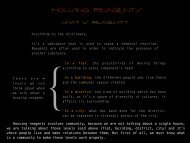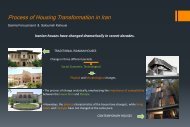Housing Concepts - Oikodomos
Housing Concepts - Oikodomos
Housing Concepts - Oikodomos
You also want an ePaper? Increase the reach of your titles
YUMPU automatically turns print PDFs into web optimized ePapers that Google loves.
OIKODOMOS <strong>Housing</strong> <strong>Concepts</strong><br />
SYSTEM<br />
<strong>Housing</strong> can never be seen in isolation. It is always part of a larger ensemble: a<br />
settlement, a city and the built environment. Considered as an object, a house is<br />
always in relationship with other elements: houses and buildings, the surrounding<br />
spaces and the landscape. In order to address housing planning and design, we<br />
cannot lose sight of the fact that a house is always part of a greater assemblage<br />
of interrelated elements.<br />
An organisation of parts within a whole is usually understood as a structure. A<br />
system, on the other hand, is a structure with a functional purpose. A structure<br />
is a stable organisation, while a system is a dynamic set of interactions. A<br />
systems-oriented approach to housing conveys not only an understanding of its<br />
structural condition but of the functional purpose of the system in which housing<br />
is embedded. For example, we can see housing as part of an ecosystem aimed at<br />
reducing energy consumption or as part of an industrialised system whose goal is<br />
to produce the maximum number of housing units at a minimal cost.<br />
The notion of a system is equally applicable to living beings, physical reality<br />
and abstract thinking. In fact, systems-oriented thinking blurs the separation<br />
between these realms, between the natural and the artificial, and between the<br />
physical and the abstract (von Bertalanffy, 1968).<br />
A system is always dynamic, because it’s a conceptualisation of the interactions<br />
between the parts that make the whole, and in turn between these and the<br />
environment. Accordingly, a systems-oriented approach applied to housing design<br />
and planning would pay attention to the dynamic relationship between the elements<br />
-- physical and abstract -- which comfort housing and other elements of the built<br />
environment.<br />
Van Eyck Orphanage:<br />
In the 1950s, Team X<br />
introduced concepts<br />
such as clustering,<br />
association and growth<br />
to overcome the notion<br />
of functionalism<br />
postulated by the<br />
modern movement.<br />
These ideas were<br />
synthesised in the<br />
term “mat-building”.<br />
According to Smithson,<br />
“this concept of<br />
building to epitomize<br />
the anonymous<br />
collective; where the<br />
functions come to<br />
enrich the fabric and<br />
the individual gains<br />
new freedoms of action<br />
through a new shuffled<br />
order, based on<br />
interconnection,<br />
close-knit patterns of<br />
association and<br />
possibilities for<br />
growth, diminution and<br />
change”.






